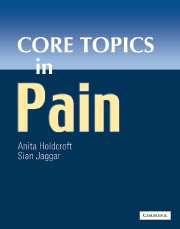Book contents
- Frontmatter
- Contents
- Contributors
- Preface
- Acknowledgements
- Foreword
- General abbreviations
- Basic science abbreviations
- PART 1 BASIC SCIENCE
- PART 2 PAIN ASSESSMENT
- Section 2a Pain measurement
- Section 2b Diagnostic strategies
- PART 3 PAIN IN THE CLINICAL SETTING
- Section 3a Clinical presentations
- Section 3b Pain syndromes
- PART 4 THE ROLE OF EVIDENCE IN PAIN MANAGEMENT
- PART 5 TREATMENT OF PAIN
- Section 5a General Principles
- 32 Overview of treatment of chronic pain
- 33 Multidisciplinary pain management
- Section 5b Physical treatments
- Section 5c Pharmacology
- Section 5d Psychosocial
- PART 6 SUMMARIES
- Glossary
- Index
32 - Overview of treatment of chronic pain
from Section 5a - General Principles
Published online by Cambridge University Press: 10 December 2009
- Frontmatter
- Contents
- Contributors
- Preface
- Acknowledgements
- Foreword
- General abbreviations
- Basic science abbreviations
- PART 1 BASIC SCIENCE
- PART 2 PAIN ASSESSMENT
- Section 2a Pain measurement
- Section 2b Diagnostic strategies
- PART 3 PAIN IN THE CLINICAL SETTING
- Section 3a Clinical presentations
- Section 3b Pain syndromes
- PART 4 THE ROLE OF EVIDENCE IN PAIN MANAGEMENT
- PART 5 TREATMENT OF PAIN
- Section 5a General Principles
- 32 Overview of treatment of chronic pain
- 33 Multidisciplinary pain management
- Section 5b Physical treatments
- Section 5c Pharmacology
- Section 5d Psychosocial
- PART 6 SUMMARIES
- Glossary
- Index
Summary
Patients go to doctors not because a disease process starts or reaches a certain level; but rather to get help with problems that they perceive to have a medical solution. This is important as it underpins the reason that only approximately 15% of patients visiting their general practitioners (GPs) have identifiable pathology, and the observation that some people visit their doctor weekly, while others virtually never attend.
The way that physicians tackle the challenge of helping the person in front of them varies substantially between hospital medicine and primary care. In hospitals the above point, while perhaps not forgotten, becomes irrelevant in the reductionist pursuit of the cause of the problem that drives investigation and treatment. In primary care on the other hand, a much more problem-focused approach is adopted. The model is broader and acknowledges that the needs of the whole person must be addressed.
Patients with chronic pain attending hospital pain clinics fall somewhere between these two polarities. Pain clinicians rightly consider themselves to have a sophisticated scientific understanding of pain and practice evidence-based medicine. However, they also advocate a biopsychosocial model, where issues beyond the purely biological are taken into account. At least half of pain clinic patients will not have a clearly identifiable pathology to account for their pain; ultimately pain is always a subjective experience known only to the sufferer.
- Type
- Chapter
- Information
- Core Topics in Pain , pp. 219 - 222Publisher: Cambridge University PressPrint publication year: 2005



